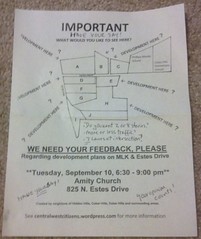The Central West draft plan was presented to the Planning Board last night. Given the issues the Central West steering committee had coming to an agreement on a plan, and how the committee ended up costing much more than was expected, I had low expectations for the output of the steering committee. However, I was pleasantly surprised by the draft plan. The plan is mostly multifamily residential, and not particularly tall (3-4 stories, with one 5-8 story area that is completely separate from all the other areas on the map by open space). It makes ample use of trail connectors and other infrastructure to increase bike and pedestrian safety, which will be a welcome improvement to the area. I personally think the buildings at the corner of Estes and MLK could be a bit taller, but credit should be given to steering committee co-chairs Amy Ryan and Michael Parker for putting together a plan that tried to acknowledge and address the wide range of issues and viewpoints of those that participated in the process.
I live in the Central West impact area, and attended the public interest meeting on September 10th at Amity United Methodist Church. It was a disheartening experience. While I am used to being one of the younger people in the room at public meetings, the people in attendance skewed older than the demographics of our neighborhood. Red and green dots were used to convey like and dislike for areas of the 4 potential draft plans. People were covering up my dots with their own, and there was no way for staff to counter any misconceptions about the plan on a large scale. I left feeling like my voice wasn't heard.
 The people at this meeting are not representative of most of the
town. And they weren't even representative of my
neighborhood, which has sizeable apartment and public housing
populations. Many of them came out to the meeting because of flyers
with incorrect information placed into their mailbox (my own
included- see the picture). Some of these people have
been decrying the Chapel Hill News' portrayal of them as a
"vocal minority" (examples here,
here,
and here).
The people at this meeting are not representative of most of the
town. And they weren't even representative of my
neighborhood, which has sizeable apartment and public housing
populations. Many of them came out to the meeting because of flyers
with incorrect information placed into their mailbox (my own
included- see the picture). Some of these people have
been decrying the Chapel Hill News' portrayal of them as a
"vocal minority" (examples here,
here,
and here).
Demographically, they are a minority. The median age in Chapel Hill is 25.6 years old, and 23% of our population is 20-24 years old (I'm using 2008 data, since the US Census website is shut down). We are a young town, but the young voice is being lost in this process. Also lost are those who are slightly older (ages 25-45). Compared to the percentages of the rest of our region, the percentage of young professionals in our community are miniscule. The university is bringing young people in, but due to a lack of desirable, affordable housing (which are usually the walkable, more urban neighborhoods the "vocal minority" derides), only those with means (or luck to find one of the few affordable places in town) are able to stay after graduation.
I am one of the lucky ones. At age 28, I am a rarity in Chapel Hill. Almost all of my friends who went to college with me at UNC have moved away. Those that have stayed in the area are mostly in Durham, where housing is cheaper, and nicer for the price. I stay here, even though I commute to Raleigh every day, because I love and care about this town, but it's often a lonely place to be. And there is a sizeable population who is trying to derail the development of housing here that is 1) what is attractive to me as a renter or potential homebuyer, and 2) will decrease the price of housing overall by glutting the market.
Much of the language of the "vocal minority" is couched in environmentalism. Some concerns (traffic, stormwater) that they raise are valid. But it boils down to a micro vs. macro issue. What is more environmentally friendly- creating a place where people can bike/walk/take transit, or forcing people without great means to other areas in the region where they would be more likely to drive, due to longer commutes and poorer infrastructure? Nearly half (49%) of all greenhouse gas emissions in Orange County are from transportation. Low-density housing (or no housing at all) will continue to add to our county's footprint, by forcing more people to drive in from other areas to work, attend school, or play, and will create more of the traffic that many in this group of people are concerned about. Low/no dense development is the antithesis of environmentalism. And as an environmentalist myself, the irony that many of the people making the "environmentalism" argument live in large, resource-guzzling homes and do not walk, bike, or take transit is not lost on me.
I want Chapel Hill to be welcoming place for people of all ages and family types to live. Housing prices will continue to increase if we don't add to the housing market, making living here, which is already difficult to achieve for many, impossible. Instead of using environmental rhetoric, those in the "vocal minority" should be honest and tell the truth: you don't want me (and others like me) here. And if you keep trying to yell over the quiet majority, you will probably get your wish.
Note: for more Orange County demographic data while the Census data is unavailable, check out the Chamber's State of the Community Report.